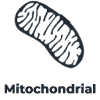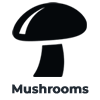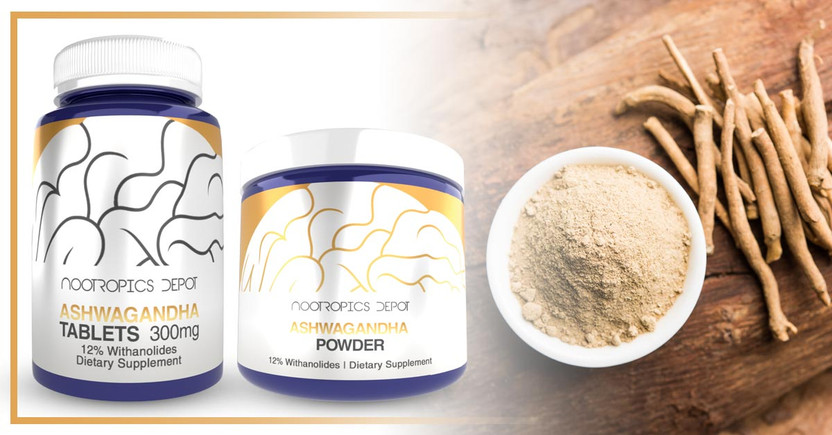Ashwagandha Benefits | An Ayurvedic Herb for Stress Support, Immune Health, and Restful Sleep
Posted by Nootropics Depot on 20th Sep 2021
Ashwagandha: An Adaptogen Supplement
There are thousands of different herbs that get used by various traditional practices and systems in several cultures, yet each of these cultures and traditional systems have a few different herbs that they keep in very high regard. In traditional Chinese practices, this herb is Panax ginseng, which is seen as being able to aid the body function better in almost every regard. It is seen as a true panacea. In a similar vein, Ashwagandha is one of the most widely discussed and used herbs in Ayurveda. It too is seen as a panacea that can help the body function better. In fact, in Ayurveda, Ashwagandha is one of various "Rasayana" herbs, which loosely translates to "rejuvenator." In more modern interpretations, Ashwagandha is often times classified as an adaptogen supplement. The term "adaptogen" is a fairly modern interpretation of a concept that was developed more than 70 years ago by N.V. Lazarev, a Russian pharmacologist. In 1947 N.V. Lazarev was running various experiments with dibazol, a compound which acts as an arterial dilator. During these experiments he was starting to observe an effect he had never encountered before. It seemed that dibazol was non-specifically balancing biological processes within an organism while they were being exposed to adverse influences such as stress. He called this effect SNIR, which stands for "a state of nonspecifically increased resistance."
Following the initial dibazol experiments, many other SNIR compounds followed and were shown to allow individuals to better cope with mental and physical stress. The thing that made these SNIR compounds very unique, is that they seemed to give the body what it needed. This mechanism of action later led to SNIR compounds being referred to as ‘adaptogens’ as they are able to adapt to our bodies needs. Although the term ‘adaptogen’ was coined fairly recently, adaptogens have actually been in use for thousands of years. Ancient traditional systems, such as Ayuverdic practices, were aware of these balancing effects for a very long time. Part of the reason why there is such a large emphasis on balancing and rejuvenation in traditional systems is because adaptogens are abundantly present throughout nature. For example, besides Ashwagandha, Nootropics Depot carries a plethora of other adaptogens such as:
These are natural substances and are highly regarded traditionally for their rejuvenating effects. In fact, all adaptogens are now classified as natural herbs and plants with synthetic molecules that have adaptogen-like effects being referred to as actoprotectors.
Now, with there being so many adaptogens, it is often times hard to choose which one to supplement with. Luckily, adaptogens have a wide range of effects. Some can be a little bit more energizing while others can be much more calming. What makes Ashwagandha unique is that it is very calming and great for stress management while not causing much lethargy. This makes it one of the best adaptogens to keep a level head at all times, while making sure our bodies stay healthy and happy, even during times of enhanced stress.
Ashwagandha: An Adaptogen Supplement
There are thousands of different herbs that get used by various traditional practices and systems in several cultures, yet each of these cultures and traditional systems have a few different herbs that they keep in very high regard. In traditional Chinese practices, this herb is Panax ginseng, which is seen as being able to aid the body function better in almost every regard. It is seen as a true panacea. In a similar vein, Ashwagandha is one of the most widely discussed and used herbs in Ayurveda. It too is seen as a panacea that can help the body function better. In fact, in Ayurveda, Ashwagandha is one of various "Rasayana" herbs, which loosely translates to "rejuvenator." In more modern interpretations, Ashwagandha is often times classified as an adaptogen supplement. The term "adaptogen" is a fairly modern interpretation of a concept that was developed more than 70 years ago by N.V. Lazarev, a Russian pharmacologist. In 1947 N.V. Lazarev was running various experiments with dibazol, a compound which acts as an arterial dilator. During these experiments he was starting to observe an effect he had never encountered before. It seemed that dibazol was non-specifically balancing biological processes within an organism while they were being exposed to adverse influences such as stress. He called this effect SNIR, which stands for "a state of nonspecifically increased resistance."
Following the initial dibazol experiments, many other SNIR compounds followed and were shown to allow individuals to better cope with mental and physical stress. The thing that made these SNIR compounds very unique, is that they seemed to give the body what it needed. This mechanism of action later led to SNIR compounds being referred to as ‘adaptogens’ as they are able to adapt to our bodies needs. Although the term ‘adaptogen’ was coined fairly recently, adaptogens have actually been in use for thousands of years. Ancient traditional medicine systems, such as ayuverdic medicine, were aware of these balancing effects for a very long time. Part of the reason why there is such a large emphasis on balancing and rejuvenation in traditional medicine systems is because adaptogens are abundantly present throughout nature. For example, besides ashwagandha, Nootropics Depot carries a plethora of other adaptogens such as:
These are natural substances and are highly regarded traditionally for their rejuvenating effects. In fact, all adaptogens are now classified as natural herbs and plants with synthetic molecules that have adaptogen-like effects being referred to as actoprotectors.
Now, with there being so many adaptogens, it is often times hard to choose which one to supplement with. Luckily, adaptogens have a wide range of effects. Some can be a little bit more energizing while others can be much more calming. What makes Ashwagandha unique, is that it is very calming and great for stress management while not causing much lethargy. This makes it one of the best adaptogens to keep a level head at all times, while making sure our bodies stay healthy and happy, even during times of enhanced stress.
Ashwagandha: An Adaptogen Supplement
There are thousands of different herbs that get used by various traditional practices and systems in several cultures, yet each of these cultures and traditional systems have a few different herbs that they keep in very high regard. In traditional Chinese practices, this herb is Panax ginseng, which is seen as being able to aid the body function better in almost every regard. It is seen as a true panacea. In a similar vein, Ashwagandha is one of the most widely discussed and used herbs in Ayurveda. It too is seen as a panacea that can help the body function better. In fact, in Ayurveda, Ashwagandha is one of various "Rasayana" herbs, which loosely translates to "rejuvenator." In more modern interpretations, Ashwagandha is often times classified as an adaptogen supplement. The term "adaptogen" is a fairly modern interpretation of a concept that was developed more than 70 years ago by N.V. Lazarev, a Russian pharmacologist. In 1947 N.V. Lazarev was running various experiments with dibazol, a compound which acts as an arterial dilator. During these experiments he was starting to observe an effect he had never encountered before. It seemed that dibazol was non-specifically balancing biological processes within an organism while they were being exposed to adverse influences such as stress. He called this effect SNIR, which stands for "a state of nonspecifically increased resistance."
Following the initial dibazol experiments, many other SNIR compounds followed and were shown to allow individuals to better cope with mental and physical stress. The thing that made these SNIR compounds very unique, is that they seemed to give the body what it needed. This mechanism of action later led to SNIR compounds being referred to as ‘adaptogens’ as they are able to adapt to our bodies needs. Although the term ‘adaptogen’ was coined fairly recently, adaptogens have actually been in use for thousands of years. Ancient traditional medicine systems, such as ayuverdic medicine, were aware of these balancing effects for a very long time. Part of the reason why there is such a large emphasis on balancing and rejuvenation in traditional medicine systems is because adaptogens are abundantly present throughout nature. For example, besides ashwagandha, Nootropics Depot carries a plethora of other adaptogens such as:
These are natural substances and are highly regarded traditionally for their rejuvenating effects. In fact, all adaptogens are now classified as natural herbs and plants with synthetic molecules that have adaptogen-like effects being referred to as actoprotectors.
Now, with there being so many adaptogens, it is often times hard to choose which one to supplement with. Luckily, adaptogens have a wide range of effects. Some can be a little bit more energizing while others can be much more calming. What makes Ashwagandha unique, is that it is very calming and great for stress management while not causing much lethargy. This makes it one of the best adaptogens to keep a level head at all times, while making sure our bodies stay healthy and happy, even during times of enhanced stress.
What is Ashwagandha?
Ashwagandha is a herb that belongs to the night shade family of plants. The nightshade family of plants is a very interesting one and includes a lot of vegetables that make up large parts of many diets. Notable nightshade members are potatoes, tomatoes, chili peppers, goji berries and even tobacco! Another name for the nightshade family is Solanaceae. This is where Ashwagandha gets its Latin name from; Withania somnifera. Ashwagandha is a short perennial shrub, with a large root system that develops small deep orange fruits. The fruits resemble a small cherry and the leaves look frosty due to the many tiny hairs that are on them. This one of the reasons why Ashwagandha is also referred to as ‘winter cherry’. Traditionally, the Ashwagandha root is used, however new research has found high concentrations of key components in the leaves too. Various manufacturers have taken notice of this. One of the most notable being Natreon who produce a specialized extract of Ashwagandha called Sensoril. Sensoril is made from the leaves of Ashwagandha, giving it a unique chemical composition, which produces noticeable calming effects.
What is Ashwagandha?
Ashwagandha is a herb that belongs to the night shade family of plants. The nightshade family of plants is a very interesting one and includes a lot of vegetables that make up large parts of many diets. Notable nightshade members are potatoes, tomatoes, chili peppers, goji berries and even tobacco! Another name for the nightshade family is Solanaceae. This is where Ashwagandha gets its Latin name from; Withania somnifera. Ashwagandha is a short perennial shrub, with a large root system that develops small deep orange fruits. The fruits resemble a small cherry and the leaves look frosty due to the many tiny hairs that are on them. This one of the reasons why Ashwagandha is also referred to as ‘winter cherry’. Traditionally, the Ashwagandha root is used, however new research has found high concentrations of key components in the leaves too. Various manufacturers have taken notice of this. One of the most notable being Natreon who produce a specialized extract of Ashwagandha called Sensoril. Sensoril is made from the leaves of Ashwagandha, giving it a unique chemical composition, which produces noticeable calming effects.
What is Ashwagandha?
Ashwagandha is a herb that belongs to the Nightshade family of plants. The Nightshade family of plants is a very interesting one and includes a lot of vegetables that make up large parts of many diets. Notable nightshade members are potatoes, tomatoes, chili peppers, goji berries and even tobacco! Another name for the Nightshade family is Solanaceae. This is where Ashwagandha gets its Latin name from: Withania somnifera. Ashwagandha is a short perennial shrub with a large root system that develops small deep orange fruits. The fruits resemble a small cherry and the leaves look frosty due to the many tiny hairs that are on them. This is one of the reasons why Ashwagandha is also referred to as "winter cherry." Traditionally, the Ashwagandha root is used; however, new research has found high concentrations of key components in the leaves too. Various ingredient manufacturers have taken notice of this. One of the most notable being Natreon who produce a specialized extract of Ashwagandha called Sensoril. Sensoril is made from the leaves of Ashwagandha, giving it a unique chemical composition, which produces noticeable calming effects.
What Compounds Are In Ashwagandha?
As mentioned above, Ashwagandha supplements can be made from various parts of the plant. The motivation behind using different parts of the plant comes down to which compounds an ingredient manufacturer is interested in extracting. As mentioned earlier, Sensoril is made from the leaves of Ashwagandha, which yields very high levels of glycowithanolides. However, glycowithanolides only make up a small portion of the chemical composition of Ashwagandha. Below is an extensive list of the main active constituents in Ashwagandha:
- Withanone
- Withaferin A
- Withanolide A-D
- Withanoside IV and VI
- Withanolide Z
- Glycowithanolides
- Physagulin
- Ashwagandhanolide
- Withanolide sulfoxide
- Viscosa lactone B
- Kaempferol
- Naringenin
- (+)-Catechin
- β-sitosterol
- Stigmaterol
- Trigonelline
Together, all of these compounds create significant health-boosting, stress-lowering and cognition-boosting effects. However, there are a few key players that produce the majority of the effects and these are usually referred to as the withanolides and glycowithanolides. Due to this, you will often see products that are standardized to withanolides such as our basic Ashwagandha which is standardized to 12% withanolides. That being said, even though the other compounds present in Ashwagandha aren’t being standardized for, they still exist in Ashwagandha extracts and help boost the effectiveness of withanolides. As a very general rule of thumb, extracts that are standardized for the glycowithanolides are going to be very calming because they have significant effects on our GABA system. Extracts that more generally standardize for withanolides are going to be more balanced and more adaptogenic. Keep this in mind when picking a Ashwagandha supplement. Below are some brief description of each Ashwagandha supplement we carry:
- Sensoril Ashwagandha: Sensoril Ashwagandha is high in glycowithanolides making it a potent and calming extract. Sensoril is made from a blend of Ashwagandha root and leaf extracts, which is part of the reason why it is so potent. Sensoril is best taken during periods of high stress, or to help enhance sleep quality.
- KSM-66 Ashwagandha: KSM-66 is extracted using milk. Traditionally, Ashwagandha root powder is mixed with milk to enhance absorption, and so Ixoreal Bioscience decided to use milk as its extraction solvent. The end result is an Ashwagandha root only extract that is very well balanced. Effect-wise, KSM-66 is very uplifting and can help support healthy stress levels.
- Shoden Ashwagandha: Shoden is a full spectrum Ashwagandha extract made using roots and leaves. Standardized to 35% withanolides, Shoden carries high levels of 8 key Withanolide Glycosides and high levels of Withanoside X, a bioactive glycowithanolide. These elements, along with high bioavailability, makes Shoden® a full spectrum Ashwagandha extract with a well-rounded Ashwagandha effect profile.
- Basic Ashwagandha: Nootropics Depot's basic Ashwagandha is made from both Ashwagandha root and leaves and is standardized to 12% withanolides. This Ashwagandha extract is uplifting and calming without being too calming or too energizing. Many people tend to prefer this Ashwagandha extract because it is so well balanced.
Traditional Uses of Ashwagandha
As mentioned earlier, Ashwagandha root has been used for centuries. So, what makes it so attractive and why has it been used for so long? Traditionally, before we could determine via scientific studies what effects Ashwagandha had on the body, Ashwagandha was already being used for many of the same applications as it currently is. It was mainly used in India, in Ayurva as a rejuvenator, supporting the body from fatigue and stress. Other potential Ashwagandha benefits include:
- Promoting relaxation
- Promoting balanced inflammation levels
- Promoting healthy cognitive function
- Promoting physical strength
As mentioned earlier, traditional preparation of Ashwagandha root involved the use of milk. This is due to the fact that Ashwagandha contains both water and fat-soluble compounds. Milk, being a mixture of both water and fat, allows for efficient extraction and absorption of the bioactive molecules contained within Ashwagandha. This allows for the highest amount of Ashwagandha benefits.
Summary of Ashwagandha Benefits
Ashwagandha Stress Benefits
One of the biggest limiting factors to our overall cognitive health is the physiological effects of elevated stress. Besides feeling "stressed," which can manifest itself as feelings of uncontrollable energy contrasted by paradoxical mental exhaustion, there is a lot going on in our bodies and brains when we are exposed to abnormal levels of stress. One of the main biochemical responses to stress is a rapid elevation in the levels of various stress hormones called corticosteroids. One of the most well known corticosteroids is cortisol which is produced by our adrenal cortex. Cortisol plays a role in a large variety of processes in our bodies, which under normal condition are very beneficial to our overall health. In fact, cortisol becomes elevated at certain points in the day. For example, cortisol is highly elevated in the mornings. Under normal circumstances, this will help us feel alert and motivated while also ramping up our metabolism. Cortisol levels drop later in the day, which will decrease alertness and make it easier to relax and go to sleep. Under elevated stress, these normal fluctuations in cortisol levels (which are collectively referred to as the diurnal cortisol curve) can become dis-regulated. This can manifest itself in a variety of different ways, such as a flat plateau, where cortisol levels increase in the morning and remain elevated. It can also completely flip around, resulting in low morning cortisol levels and high evening cortisol levels. In a real world interpretation, this may cause excessive stimulation during the day, excessive tiredness in the morning or excessive stimulation at night. Bare in mind, these are just the effects of disregulated cortisol that we can perceive. There is a whole lot more going on under the hood.
Elevated cortisol levels may have a negative effect on the cells contained in a part of our brains called the hippocampus. It is thought that a large portion of memory processing, especially the acquisition stage of memory, occurs in the hippocampus. Thus, it is no surprise that elevated cortisol levels in response to stress, can hamper memory function. Furthermore, elevated corticosteroid levels in response to stress can also significantly dampen our natural immune response. A combination of hampered cognitive and immune function can be very detrimental to productivity and can be a big blow to our general quality of life. So how do we minimize the physiological impact of stress in such a high stress world? One of the best options is identifying your main sources of stress and attempting to manage them on a behavioral level. However, sometimes this is not possible and we need a little extra help. Luckily, Ashwagandha has some powerful stress management benefits.
Withanolide A, one of the major bioactive molecules in Ashwagandha, has been reported to normalize elevated corticosteroid levels during elevated stress. Through this mechanism of action, Ashwagandha can help protect us from the potential negative effects of elevated cortisol levels. This mechanism of action, can also help support our memory, help promote overall cognitive function and help promote immune system strength.
Ashwagandha Brain Health Benefits
The withanolides have also been shown to promote overall brain health. They can achieve this by providing robust neuroprotective effects through normalizing elevated glutamate levels. Glutamate is an important excitatory neurotransmitter. In normal levels, glutamate helps us form and store memories. However, in abnormally high levels, it can cause damage to our brain cells. By normalizing glutamate levels, Ashwagandha can help promote overall brain health.
The glycowithanolides in contrast to the withanolides are not as stress reducing. Rather, they appear to be very neuroprotective and calming. Various studies have shown that glycowithanolides can help promote relaxation and a positive mood. One of the mechanisms by which glycowithanolides appear to achieve this is by normalizing the levels of tribulin. Levels of tribulin increase when stress levels are elevated and may cause feelings of restlessness and a gloomy mood. Via reducing tribulin levels, Ashwagandha may help regulate these feelings of restlessness and instead may promote relaxation and a positive mood. Ashwagandha benefits also appear to extend to the GABA system. Ashwagandha does this by enhancing signaling through the GABA A receptor, which is one of the primary inhibitory receptors in the brain. By enhancing signaling through the GABA A receptor, Ashwagandha may be able to promote significant feelings of relaxation, which may even translate to improved sleep quality!
Ashwagandha Immune Health Benefits
Withanolide A has been shown to help normalize our immune system during periods of stress. It does this through a few mechanisms. The first is normalizing elevated corticosteroid levels which will result in a general normalizing effect on our immune system. However, Withanolide A goes a step further and appears to increases the expression of the Th1 cytokines, interferon gamma, and interleukin-2 while decreasing the Th2 cytokine, interleukin-4. These compounds are all important regulators of our immune system, and the specific shift that withanolide A is able to induce may help promote stronger immune function.
"Research has shown that magnesium levels are decreasing in most foods... With the magnesium content decreasing in crops and the increase in the consumption of processed foods, magnesium deficiencies in the population are becoming more prevalent."
Ashwagandha Sleep Benefits
As we mentioned earlier, stress can have a major impact on sleep if it starts to shift our diurnal cortisol curve to elevated cortisol levels at night. This will make it hard for us to unwind from a busy day, which makes it very hard to get into a relaxed enough state to fall asleep. This is often characterized by racing thoughts at bed time, which in the worst-case scenario may keep us tossing and turning all night, resulting in exhaustion the following day. Since Ashwagandha can normalize cortisol levels, this alone can help improve our sleep quality.
The sleep benefits of Ashwagandha also extend to the GABA system. Sleep is a very complex phenomenon, but we have come to the understanding now that GABA plays a critical role in the initial stages of sleep. GABA is referred to as an inhibitory neurotransmitter. Metaphorically speaking, think of GABA as the brake in your car. GABA gives us the ability to slow down our brain, allowing it to enter a state of lowered activity which will help facilitate sleep.
Which is The Best Ashwagandha Supplement For Me?
One of the biggest difficulties with Ashwagandha is knowing exactly what to test for. Our response to this challenge was to develop a highly comprehensive profile of withanolides that we test for. With a lot of the Chinese extracts we were testing, we found that they were quite high in Withaferin A while being low in other withanolides. Since Withaferin A is a withanolide, it can be grouped under "total withanolides." This means that sometimes extracts that contain 5% total withanolides actually contain pretty much only Withaferin A. While Withaferin A is a very beneficial compound, it does not produce the classic calming effects associated with Ashwagandha. With this in mind, it is important that we test for Withaferin A independently of the other withanolides so that we can ensure that we are standardizing for a balanced withanolide profile. All of the withanolides each have very unique and distinct effects, so simply lumping it all under "total withanolides" and calling it a day, is a direct path to oftentimes lacklustre and unbalanced ashwagandha extract.
This is where our new testing methods came to the rescue. Since our new testing methods allow us to distinguish accurately between different withanolides, it allows us to pursue specific withanolide profiles in the extracts we source. By doing this, we can achieve a few things such as:
-
-
- More consistent Ashwagandha extracts
- Higher potency
- Balanced withanolide profile
- Extracts that are NOT made up of only withaferin A
-
Overall, this means that our new Ashwagandha extract standardized to an impressive 12% withanolides is going to be one of the best Ashwagandha extracts around!
As we mentioned earlier in this article, there are various different forms of Ashwagandha on the market. At Nootropics Depot, we carry four different forms: Sensoril, KSM-66, Shoden, and our basic Ashwagandha.
We described how each of these extracts works, based on the bioactive compounds in each, but we haven’t touched on the practical applications yet. The question remains: Which Ashwagandha supplement should I take to maximize Ashwagandha benefits for myself? Below is our answer. Albeit somewhat general, we have formed the following opinions about the extracts that we carry:
- Sensoril Ashwagandha Extract: This extract is by far the most calming. For people whom are stressed and are feeling excessive energy, this would be a great Ashwagandha supplement to promote relaxation. Sensoril, through its calming actions, is also the best option for those looking to capitalize on Ashwagandha sleep benefits. For individuals whom are feeling more exhausted and sluggish, this would not be the best choice as it may bring about feelings of lethargy.
- KSM-66 Ashwagandha Extract: This Ashwagandha root extract is said to promote energy and vitality. In fact, KSM-66 even appears to be a very invigorating extract and can produce a bit of an energy lift while promoting a positive mood. For individuals whom are stressed and feeling excessive energy, this may not be the best Ashwagandha supplement to take as it may not adequately calm them down in the manner that they are hoping for.
- Shoden Ashwagandha: Shoden is a full spectrum Ashwagandha extract standardized to 35% withanolides, Shoden carries high levels of 8 key Withanolide Glycosides and high levels of Withanoside X, a bioactive glycowithanolide. These elements, along with high bioavailability, makes Shoden® a full spectrum Ashwagandha extract with a well rounded Ashwagandha effect profile.
- Basic Ashwagandha Extract: Our basic Ashwagandha Extract would be a fantastic supplement for individuals looking for balanced stress support that will keep them happy and healthy! This extract is standardized to a minimum of 12% withanolides without an overbearing amount of Withaferin A. This ultimately means that this extract carries a balanced withanolide profile, thus promoting a balanced blend of Ashwagandha benefits.
Optimal Ashwagandha Dosage
There is not one universal Ashwagandha dosage due to the different levels of standardization. However, in general, an Ashwagandha powder extract dosage is going to be around 300-500 mg. This general Ashwagandha dosage falls in line with the various extracts we carry. For example, the Ashwagandha dosage for KSM-66 and our Ashwagandha Extract is 300 mg. The Ashwagandha dosage for Shoden and Sensoril are 120mg and 125 mg respectively, but this is due to the fact that they are more potent extracts.
How To Take Ashwagandha?
How to take Ashwagandha is a question we often times receive. For the most convenient method, we recommend using our Ashwagandha tablets. However, if you are set on Ashwagandha powder, then there are a few methods that can be used. If you are currently following a keto diet, it is easy to incorporate Ashwagandha in various keto recipes.
Add Ashwagandha To Your Coffee
One very popular keto recipe is bulletproof coffee. In this keto recipe, black coffee is mixed with grass fed butter and MCT oil. This keto recipe is a perfect vehicle for our selection of Ashwagandha powder. As mentioned earlier, Ashwagandha bioactives are both water and fat soluble which is why traditionally Ashwagandha root is consumed with milk. Bulletproof coffee mimics this somewhat by combining fats and water. Thus, adding one of our Ashwagandha powders to this keto recipe, would result in optimized absorption. We would recommend using KSM-66 Ashwagandha for this method of supplementation due to its mild and milky taste. A keto diet can actually elevate cortisol levels, and thus, Ashwagandha powder would be a fantastic addition to various beverage-based keto recipes such as Bulletproof coffee.
Ashwagandha Tea
Other mild tasting Ashwagandha powders, such as Sensoril (mild taste due to low dosage), can be used to make Ashwagandha tea. To make this Sensoril-based Ashwagandha tea; we would recommend brewing some chamomile tea, adding Sensoril powder to it, and drinking it before bed. This Ashwagandha tea recipe can be enhanced by the addition of some milk and honey, which combined with the Sensoril and chamomile, will make for a very peaceful night of sleep!
When To Take Ashwagandha?
When to take Ashwagandha is another frequently asked question. Our general advice for Ashwagandha supplements is to take them in the morning. We suggest this due to the fact that a vast majority of stress is experienced during the day. For Ashwagandha supplements such as Sensoril, we would recommend taking these about 1-2 hours before bed if the goal is to enhance sleep quality.
Interested In Alternatives?
Read our comprehensive blog on our other patented ashwagandha extracts: KSM-66, Sensoril, and Shoden. Our in-house Nootropics Depot ashwagandha is awesome, but not every extract is right for every person. We offer a huge selection of different ashwagandha extracts to suit everyone's unique body and brain chemistry. Choosing the right ashwagandha can seem complex. Let us simplify it for you!
THE BORING STUFF NOBODY READS BUT PROBABLY SHOULD
**SCOOPS: Nootropics Depot does not provide scoops or spoons with any of our products. Scoops are highly unreliable for accurate measuring. Mama didn't raise no fool! Scoops measure volume rather than weight, which is problematic because all powders have different densities. You wouldn't use a spoon to weigh yourself, would you? A milligram scale is needed to accurately measure powder products. Tools set us apart from the animals.
WARNING: Keep all supplements out of reach of children. Kids are short and stupid, so that should be easy for you. Do not take any supplement if under the age of 18, pregnant or nursing a baby (or an adult for that matter), or if you have any known or suspected medical conditions, and/or taking prescription drugs or over the counter medications.
*DISCLAIMER: Always consult with a qualified health physician before taking any new dietary supplement. If you can't find a qualified one, try an unqualified one. The products and statements found on this page are not intended to diagnose, treat, cure, or prevent any diseases. You hear that FDA? We are not talking about diseases! These statements have not been evaluated by the Food and Drug Administration, nor would we want them to.
TERMS AND CONDITIONS OF USING NOOTROPICSDEPOT.COM: The most exciting page on our website, apart from the sitemap! You can review the terms and conditions of using NootropicsDepot.com by clicking here. We know you won't, though. We will just mock you for it later.
PRIVACY POLICY: The second (third?) most exciting page on our website. You can review our privacy policy by clicking here. Nothing is private anymore. Literal babies have Instagrams now.
READ MORE NOOTROPICS DEPOT BLOGS









Ayurveda | Adaptogens | Amino Acids | Choline Supplements | Fitness Supplements | Immune Support | Metabolism Supplements | Mushroom Extracts | Natural Plant Extracts | Natural Nootropic Capsules | Natural Pain Support | Patented Nootropic Extracts | Sleep Support Supplements | Softgels | Solutions + Sublinguals | Enteric Coated Tablets | Nootropic Samples
About Nootropics Depot
Nootropics Depot is an online-based vendor of high quality nootropics, novel plant extracts, amino acids, fish oil, choline supplements, vitamins, and more based in Tempe Arizona. We were founded in 2013 with one mission: to revolutionize the lab testing and quality control standards of the supplement industry. We realized the industry needed a trusted source for these products, and consumers needed someone to champion the change the supplement industry needs. We have our own in-house analytical testing lab with some of the best analytical chemists in the supplement industry. We are constantly striving to advance and improve the purity and analytical standards of not only the nootropics industry, but the larger supplement industry as a whole.

